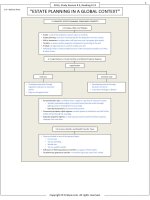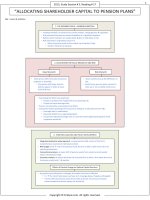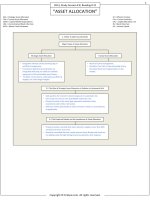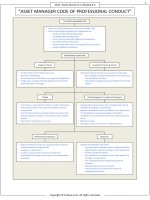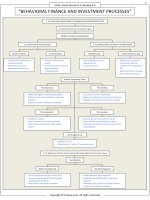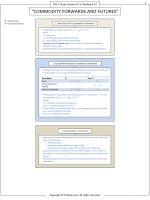FinQuiz smart summary, study session 16, reading 40
Bạn đang xem bản rút gọn của tài liệu. Xem và tải ngay bản đầy đủ của tài liệu tại đây (547.83 KB, 5 trang )
2013, Study Session # 16, Reading # 40
“MONITORING AND REBALANCING”
2. MONITORING
Fiduciary must:
Act in a position of trust.
Assess portfolio suitability relative to client’s needs & circumstances.
Monitor investor related circumstances, market & economic changes
& portfolios.
2.1 Monitoring Changes in Investor Circumstances and Constraints
∆ in the needs, circumstances or objectives of private wealth clients
(institutional clients) are reviewed on a semiannual or quarterly basis
(annual basis).
More frequent reviews may be required on client’s request or unexpected
∆ in client circumstances.
2.1.1 Changes in Investor Circumstances and Wealth
May affect income, expenditure, risk, return &
retirement income.
2.1.2 Changing Liquidity Requirements
Portfolio managers:
Provide liquidity when requested by a client.
Monitor changes in liquidity requirement.
2.1.3 Changing Time Horizons
The time horizon, investment, allocation to
bonds.
Perpetual life portfolios ⇒ few changes in time
horizon, risk budgets & asset allocation.
2.1.4 Tax Circumstances
Portfolio manager should:
Assess tax consequences of investment
decisions.
Consider client’s current & future tax
situation.
Assess tax efficiency.
2.1.5 Changes in Laws and Regulations
Managers must evaluate laws & regulations to
ensure compliance.
∆ In law affect current portfolio as well as range of
available investments.
Copyright © FinQuiz.com. All rights reserved.
1
2013, Study Session # 16, Reading # 40
2.2 Monitoring Market and Economic Changes
2.2.1 Changes in Asset Risk Attributes
A portfolio’s asset allocation may change due to ∆ in
mean return, volatility & correlation of assets.
2.2.2 Market Cycles
Major market swings provide extreme +ve or –ve
opportunities.
Investors tactically adjust asset allocations or
individual security holdings based on their opinions.
2.2.3 Central Bank Policy
Expansionary monetary policy ⇒ discount rates,
stock return.
Restrictive monitory policy ⇒ discount rates,
bond return.
2.2.4 The Yield Curve and Inflation
Default RF yield curve reflects:
Expected inflation.
Maturity premium
Time preference for real consumption.
Maturity premiums are countercyclical.
Sharpe of the Y.C depends on the economic cycle stages.
Y.C provides information about future GDP growth.
2.3 Monitoring the Portfolio
Continuous process requiring a manager to access:
Events & trends affecting asset classes & individual holdings.
∆ In asset values creating deviation from the SAA.
Copyright © FinQuiz.com. All rights reserved.
2
3
2013, Study Session # 16, Reading # 40
3. REBALANCING THE PORTFOLIO
3.1 The Benefits and Costs of Rebalancing
3.1.1 Rebalancing Benefits
3.1.2 Rebalancing Costs
In PV of expected utility losses.
Controls the level of drift in overall
portfolio risk.
Maintains desired systematic risk
exposure.
Removes overpriced assets with an
inferior returns prospect.
Transaction costs (offset rebalancing
benefits).
Tax costs if investor is taxable.
3.2 Rebalancing Disciplines
3.2.1 Calendar Rebalancing
3.2.2 Percentage-of-Portfolio Rebalancing
Periodic rebalancing to target weights (e.g.
monthly).
Rebalancing frequency may be timed to
match with portfolio reviews.
Simplest approach.
No continuous monitoring required.
Drawback:
If allocation is close to optimal
allocation rebalancing cost > benefits.
If allocation is far from the optimal,
level of market impact costs.
Rebalancing thresholds or trigger points
stated as % of portfolio value.
Require frequent monitoring.
Directly related to market performance.
Tighter control on divergence from target
allocation.
Key Determinants of the Optimal Corridor Width in a Percentage- of-Portfolio Rebalancing Program:
Factor
Effect on Optimal Width of Corridor
Factors Positively Related to Optimal Corridor Width
Transaction costs
The higher the transaction costs,
the wider the optimal corridor
Risk tolerance
The higher the risk tolerance, the
wider the optimal corridor
Correlation with rest of portfolio
The higher the correlation, the
wider the optimal corridor
Factors Inversely Related to Optimal Corridor Width
Asset class volatility
The higher the volatility of a given
asset class, the narrower the
optimal corridor
Volatility of rest of portfolio
The higher the volatility, the
narrower the optimal corridor
Intuition
Higher transaction costs set a high
hurdle for rebalancing costs to
overcome
High risk tolerance implies lower
sensitivity to divergences from
target allocations
When asset classes move in
synch, further divergence is less
likely
A given percentage move away
from the target
costly for a highly volatile asset
class, as a further divergence
becomes more likely
Makes large divergences from
strategic asset allocation more
likely
Reference: Volume 6, Exhibit 8, Reading 40, Page 93
Copyright © FinQuiz.com. All rights reserved.
2013, Study Session # 16, Reading # 40
3.2.3 Other Rebalancing Strategies
Calendar-And-Percentage-Of-Portfolio Rebalancing
Monitor the portfolio at specified intervals.
Rebalance the portfolio under % principle.
Avoid incurring rebalancing cost when the
portfolio is nearly optimal.
Equal Probability Rebalancing
Corridors are specified for each asset class.
Rebalancing is triggered when any asset class
weight moves outside its corridor.
Equal probability of triggering rebalancing.
Ignores difference in transaction costs or asset
correlations.
Tactical Rebalancing
In trending markets less frequent rebalancing.
More frequent rebalancing when markets are
characterized by reversals.
3.2.4 Rebalancing to Target Weights versus Rebalancing to the Allowed Range
Rebalancing to an allowed range has the following advantages over
rebalancing to target weights:
Transaction costs.
Tactical adjustments are possible.
Better manage the weights of illiquid asset.
Disadvantage:
Not perfectly align actual asset allocation with target proportions.
3.2.5 Setting optimal Thresholds
Optimal rebalancing strategy implies:
Maximize rebalancing benefits.
Transaction costs.
Challenges:
Rebalancing costs & benefits are difficult to measure.
Tax consequences.
Optimal strategy changes with the passage of time.
Copyright © FinQuiz.com. All rights reserved.
4
2013, Study Session # 16, Reading # 40
3.3 The Period-Sharpe Analysis of Rebalancing Strategies
3.3.1 Buy-and-Hold Strategies
3.3.2 Constant-Mix Strategies
Passive do-nothing strategy.
Floor = amount invested in T-bills.
Risk tolerance is +vely related to wealth & stock
returns.
Special case of CPPI.
In trending market this strategy outperforms constant
mix strategy.
This strategy remains neutral in flat & oscillating
market.
Portfolio value = investment in stocks +floor value.
Limited downside (floor) & unlimited upside potential.
Target stock proportion = actual stock proportion
(m=1).
3.3.3 A Constant-Proportion Strategy: CPPI
Dynamic strategy.
Buy (sell) shares as stock prices ( ).
Target investment in stock = m ×(portfolio value- floor
value).
If m>1, strategy is known as CPPI.
Investment in RF assets is dynamic.
Perform well in trending market & poor in market
characterized by reversals.
Reacts to market movements.
Target investment in stocks = m × portfolio value.
where
0
( ) actual stock proportions to m when stock
values are trending ( ).
Effectively maintains a portfolio’s systematic risk.
During strong bull & bear markets this strategy
underperforms CPPI & buy & hold.
Outperforms CPPI & buy & hold when equity returns
are characterized by reversals.
3.3.4 Linear, Concave, and Convex Investment Strategies
Constant mix & CPPI strategies are non-linear where
as buy & hold strategies are linear.
Constant-mix strategies (CPPI strategies) ⇒
relationship b/w portfolio & stock returns ⇒ concave
(convex).
Concave strategies provide liquidity to convex
strategies.
3.3.5 Summary of Strategies
Investor’s risk tolerance & asset class return expectations
are parameters for appropriate rebalancing strategies.
3.4 Execution Choices in Rebalancing
3.4.1 Cash Market Trades
Most direct means of portfolio rebalancing.
Benefits:
Favorable tax considerations.
Derivative markets may have liquidity
limitations.
Derivative strategies are not available for all
asset class exposures.
Drawbacks:
More costly & execution delay.
May impair active manager trades.
3.4.2 Derivative Trades
Rebalancing through derivative instruments.
Benefits:
Transaction costs & rapid execution.
Minimal impact of active manager strategies.
Drawbacks:
Exposure may be difficult to replicate.
Liquidity limitations in individual markets.
Copyright © FinQuiz.com. All rights reserved.
5



